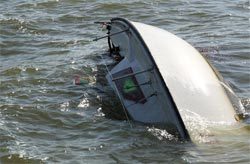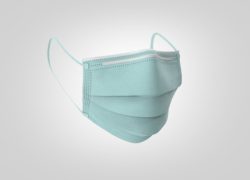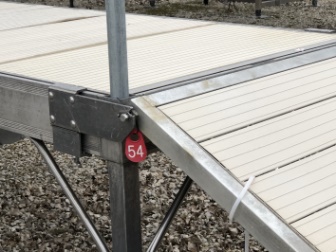Boat Lift Common Mistakes
No one wants to see this.
Imagine losing your boat even before getting it out on the water. Embarrassing – to say the least.
To keep you and your boat safe, Pier & Waterfront Solutions has some tips to avoid boat lift mistakes.
Failure to follow the manufacturer’s instructions means you’re more liking looking at a boat – IN the water, instead of – ON the water.
Never Exceed the Weight Capacity
It seems obvious, yet this happens every year. Extensive testing goes into ensuring a lift can support a calculated weight. Never ignore the results of those tests.
Engineers use a balanced load to determine the lift capacity of each unit. BOTH the weight and the load distribution are equally important to the safety of your boat lift.
Never assume a lift can support “a few extra pounds.” If the salesperson tries to sell you a lift rated for even a pound less than your boat and accessories weight, – find a different seller.
At PWS, we have the proper lift for all types of watercraft.
Give yourself plenty of wiggle room. Assume your boat weighs a couple of hundred pounds more than what even the manufacturer indicates. Then, add the extras. More on this later.
Why? It is not unusual to find several different weights listed for the same boat. Are you willing to chance the lowest listing?
The listed weight refers to the maximum weight of the craft plus all the extras.
Boaters also need to account for fuel, equipment, and anything else that will add weight to the boat.
Equally important – Properly Position the Boat.
Like a canoe in the water, balance is essential.
With a lift rating, manufacturers assume that you will balance the beams’ load when you put the boat on the lift. Only you have control over this.
On a boat lift, the boat should be equally balanced on the front and back beams. The left and right sides also should be centered. If the boat is balanced correctly, you should not be able to raise the bow at all with your hands.
A boat set too far back on the lift beams creates a light front. It’s much like the imbalance of a 100 -pound kid on one end of a seesaw with a 30 -pound kid on the other end. Waves can easily wash up beneath the front and work the boat off the lift.
At the same time, too much weight on one beam also creates extra strain on the cables. If the cables aren’t in perfect shape, they could break.
Something to consider
There are cables in each of the four corners holding your boat up. These cables distribute the weight of the boat equally to the four corners. That statement assumes you distribute the boat’s weight evenly on the rack beams in all four directions.
Assume you would like the boat sitting closer to the dock to make it easier to enter your boat. If you move the boat closer to the side of the lift frames (off-center), you are putting extra weight on the cables closest to you.
Now, put the boat a foot back on the beams.
You have not only put more weight on the two cables nearest the dock, but you have also added more weight to one cable at the “entrance” or back of the boat.
Now, add in a weakened cable, and you can see what’s coming next. Don’t let this happen to you. (Need a reminder- Look at the first image)
Load your equipment carefully.
Although you should load the boat after it’s in the water if you choose to load it before lowering the boat, distribute the load evenly.
Be Aware of Lifting Height
Please do not continue to raise the boat once it reaches the top. It seems simple enough. But wait, there’s a storm coming, and I have 1/2″ clearance between the rack and the top beam. Isn’t it best to close that gap?
Continuing to crank the winch places stress on all the parts, including the beams and possibly damaged cables. Here’s what could happen – see above.
We see this situation all the time.
Raising the boat too far may cause damage to any one of the lifting components. Some lifts automatically shut off when the lift reaches its maximum height (Hydraulic). Make sure this mechanism works as part of the lift’s routine maintenance.
Proper Loading
It may seem straightforward to load a boat while it is not rocking on the waves. However, anything loaded before lowering the boat into the water brings you closer to the lift’s maximum rating.
Loading the boat on the water helps you determine where the best weight distribution to maintain watercraft balance is.
We recommend that you lower the vessel before adding any heavy equipment or other essentials.
If your lift isn’t functioning correctly, it may be time to get a new ShoreMaster boat lift.
PWS will be happy to help you decide which lift is best for your location and type of watercraft. By talking to PWS, you can avoid making costly lift mistakes.
Want more information on this topic? Follow this link. Easier still – give the boat information to PWS. Let us do the calculations for you.
Where is Pier & Waterfront Solutions?
Pier & Waterfront Solutions, 7325 St. Hwy 57, is located 3 miles south of Sturgeon Bay. Go 1 mile PAST the intersection with County road MM (heading north). Look on the right at the next intersection – Idlewild Road and Hwy 57.
ARE WE OPEN?
Pier & Waterfront Solutions remains “open” year-round.
The virus continues to spread. PWS is conducting as much business as possible by email, text, or phone.
Site visits continue as usual. When making in-person contacts, we follow “social distancing” guidelines whenever possible.
Our display yard is OPEN 24-7
PWS‘s display area is always open for you to examine at your leisure. All displays available for sale have a numbered, red tag on them. Want more information on something you saw in our yard? Please reference that number when you inquire.
PWS will provide estimates by email to make the process faster, safer, and paperless.








